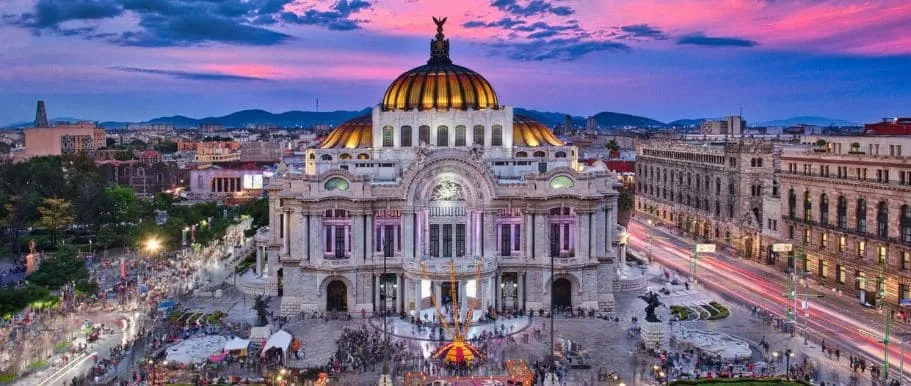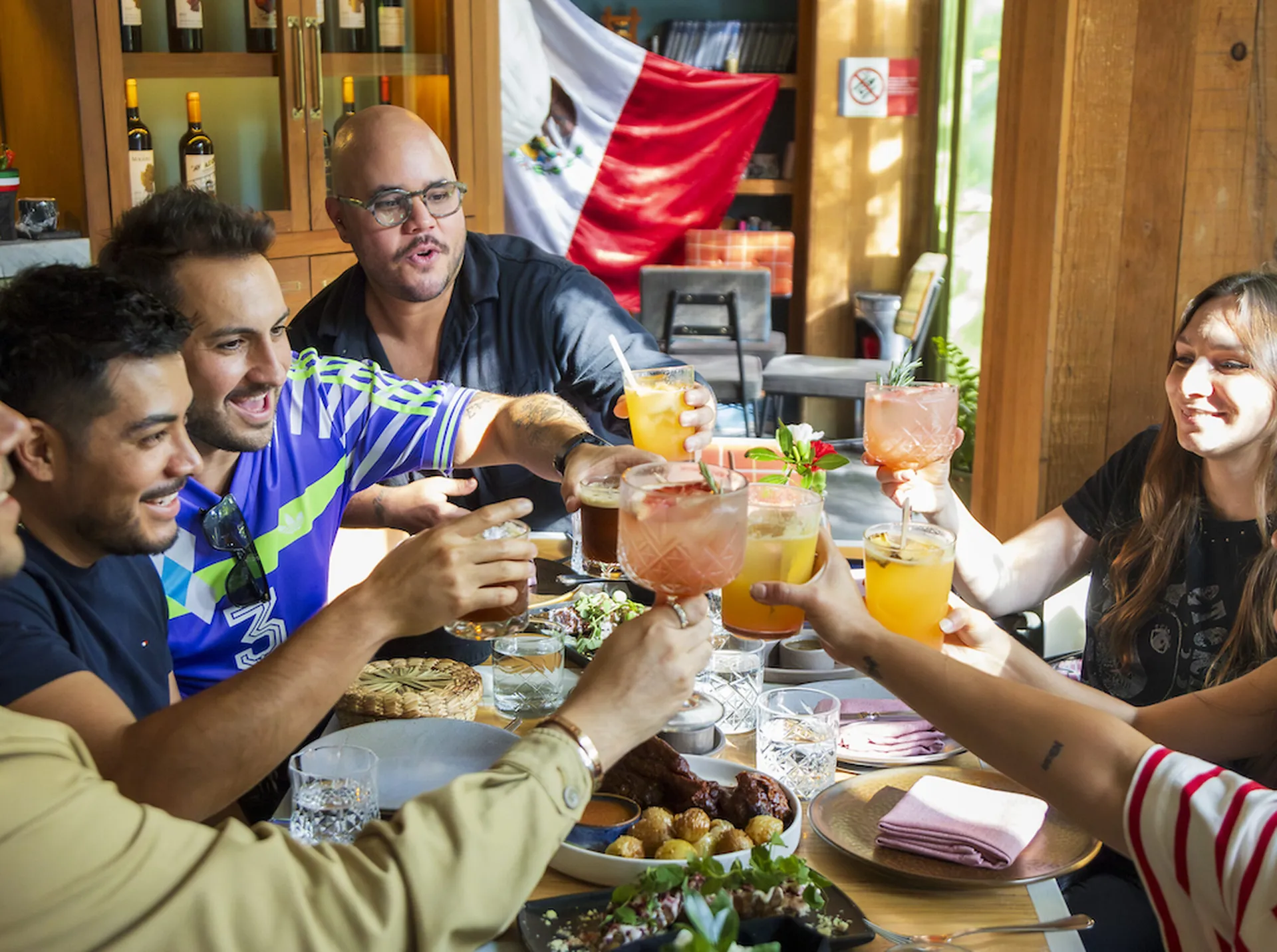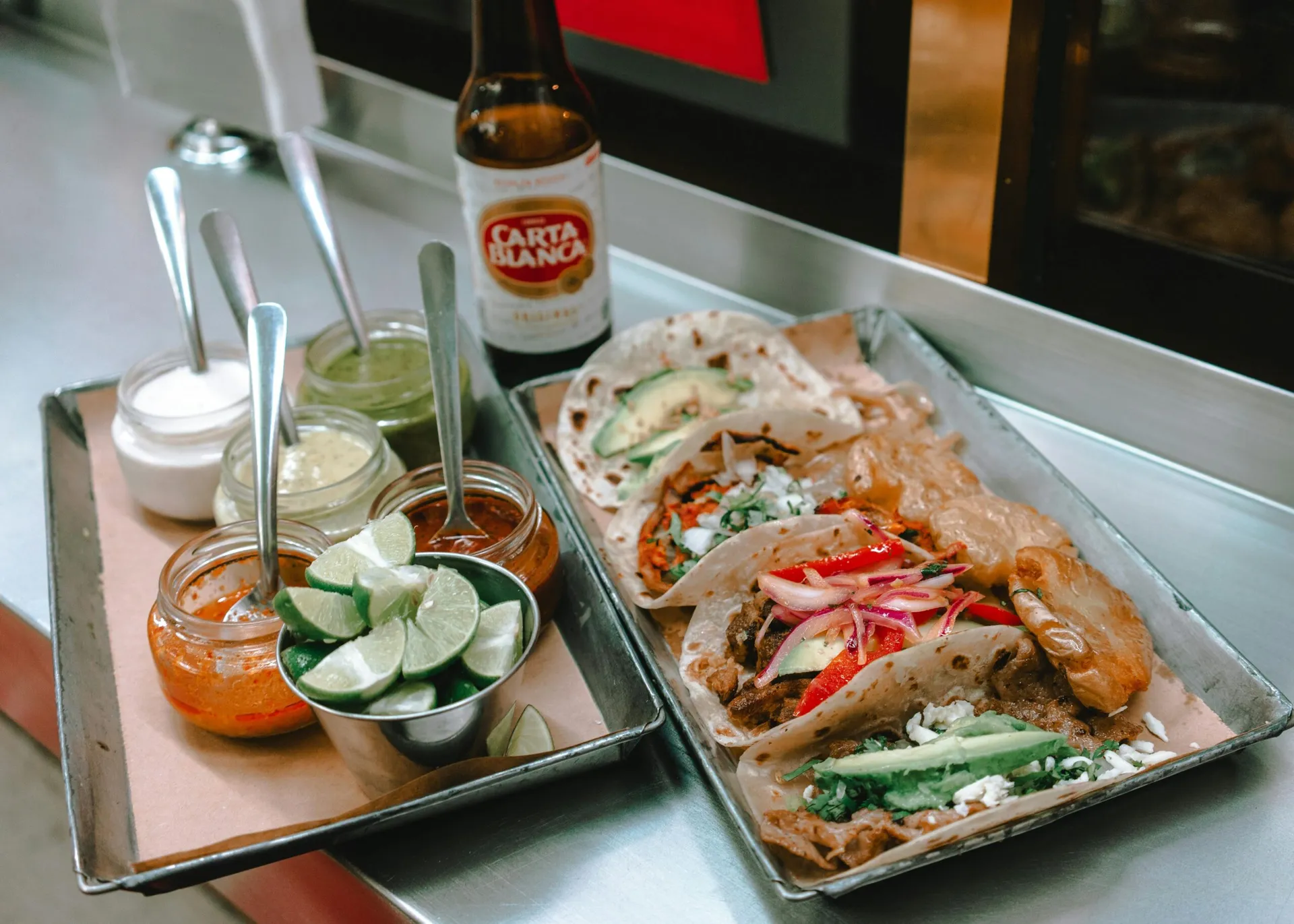If you've ever explored the lively streets of Mexico City, you might have encountered a culinary treasure that's been a cornerstone of the city's street food culture for decades: Tacos de Canasta, or "basket tacos." These delectable steamed tacos are not just a meal—they're a sensory experience that marries the bold flavors of Mexican cuisine with an ingenious method for keeping food warm and fresh while on the move. Also known as Tacos Sudados ("sweaty tacos") or Tacos al Vapor ("steamed tacos"), these treats highlight the creativity and practicality of street food vendors pedaling through Mexico City's bustling streets.
Picture the enticing aroma of chili oil, the tender texture of corn tortillas, and the savory fillings all nestled together in a woven basket. This is the essence of Tacos de Canasta—a perfect fusion of taste and texture that has won the hearts of locals and tourists alike. Whether you're a food lover eager to try new flavors or someone who admires the charm of traditional street food, Tacos de Canasta promise an unforgettable experience.
Origin and Cultural Significance
The Innovation Behind the Basket
The concept of Tacos de Canasta is deeply rooted in innovation and practicality, reflecting the resourceful spirit of Mexican street food vendors. The use of a basket, or "canasta," to keep tacos warm and fresh is a genius solution that dates back to the early 20th century. This method was essential for vendors who needed to transport and sell their tacos throughout the day without compromising their quality.
In the town of San Vicente Xiloxochitla, Tlaxcala, this innovation transformed the lives of local residents. As the profitability of working the land declined, many turned to selling tacos as a new livelihood. The basket system allowed them to prepare tacos in the morning, stack them in a wicker basket lined with cloth or butcher paper, and then transport them to Mexico City for sale. This approach ensured that the tacos remained warm and steamed, retaining their flavor and texture.
The cultural significance of Tacos de Canasta extends beyond their taste and convenience. They represent a connection between rural and urban communities, as vendors from San Vicente Xiloxochitla travel daily to Mexico City to sell their tacos. This tradition has fostered a strong sense of community and economic cooperation, with many families in Xiloxochitla involved in the production and sale of these tacos.
Today, between 50% and 80% of the families in Xiloxochitla are engaged in this industry, making it a vital part of their local economy. The historical context of Tacos de Canasta also highlights their role in serving the working class. Originally known as "tacos mineros" or "miners' tacos," these were simple, affordable meals for laborers on the go. The tradition of selling them in baskets continued to appeal to working-class citizens, providing a hot, nutritious meal that was both accessible and delicious.

How Tacos de Canasta Are Made
Preparing the Fillings
Preparing the fillings for Tacos de Canasta is an essential step that requires careful attention to detail. The fillings can vary widely, but traditional favorites include refried beans, mashed potatoes, cooked sausage (such as chorizo), and various meats like carnitas or shredded beef (carne deshebrada). One key aspect of preparing the fillings is ensuring they are on the dry side. Fillings like refried beans and mashed potatoes are ideal because they do not contain excessive moisture.
When using meats like braised beef or pork, it is essential to drain off all excess liquid to prevent the tortillas from becoming too soft and falling apart. Additional ingredients such as diced white onion, garlic, and chiles (like guajillo chiles) are often sautéed in oil to add flavor to the fillings. For example, sautéing a medium white onion and a few cloves of garlic in vegetable oil or pork lard can enhance the flavor profile of the fillings.
The Importance of the Tortilla
The tortillas used for Tacos de Canasta are typically corn tortillas, which are more pliable and better suited for steaming than flour tortillas. The quality of the tortillas is important, as they need to be strong enough to hold the fillings without tearing but soft enough to be folded and steamed effectively. Before assembling the tacos, the tortillas are often warmed on a dry griddle or in a microwave to make them more pliable. This step helps in preventing the tortillas from cracking when folded and ensures they can be steamed without losing their texture.
The Final Assembly and Steaming Process
Assembling the tacos involves placing a small amount of the prepared filling onto the center of a warmed tortilla and then folding the tortilla in half. It is important to fill the tortillas just enough to avoid overstuffing, which can cause them to break open during the steaming process.
The filled tacos are then layered in a large wicker basket, often lined with parchment paper, cloth, or butcher paper to prevent the tacos from sticking. The basket is covered with more paper or a cloth to trap the steam and keep the tacos warm.
To steam the tacos, the basket is typically covered and placed over a heat source, such as a large skillet with hot oil or a steamer. The steam generated by the heat keeps the tacos warm and fresh for several hours. This method allows vendors to transport and sell their tacos throughout the day without compromising their quality.

Variety and Popular Variants
Tacos Sudados vs. Tacos de Canasta
While the terms "Tacos de Canasta" and "Tacos Sudados" are often used interchangeably, there is a subtle distinction between them, particularly in different regions of Mexico. Tacos de Canasta specifically refer to the traditional method of steaming tacos in a basket to keep them warm, a practice that originated in San Vicente Xiloxochitla, Tlaxcala.
Tacos Sudados, on the other hand, can refer to any tacos that are steamed or kept warm in a way that makes them "sweaty." In Northern Mexico, the term "Tacos al Vapor" is more commonly used, and these tacos are cooked in a steamer rather than a basket. This variation highlights the diversity in preparation methods across different regions.
Innovative Modern Twists
Despite their traditional roots, Tacos de Canasta have seen various modern twists that cater to changing tastes and preferences. One innovative approach is the use of different types of fillings beyond the traditional refried beans, potatoes, and meats. For example, some vendors now offer fillings like tinga (shredded chicken cooked in chipotle tomato sauce), rajas con crema (sliced poblano peppers with cream), or even vegetarian options such as sautéed mushrooms and zucchini.
In addition to new fillings, modern recipes often incorporate unique flavors and ingredients. For instance, some recipes include adding salsa verde or guajillo chile oil to the fillings for an extra layer of flavor. Others might use an Instant Pot to quickly cook the fillings before assembling the tacos, making the process more efficient without compromising on taste.
Another modern twist is the presentation and serving style. While traditional Tacos de Canasta are served directly from the basket, some vendors now offer them in more contemporary settings, such as food trucks or trendy street food markets. This blend of traditional methods with modern presentation has helped keep Tacos de Canasta relevant and appealing to a new generation of food enthusiasts.

Where To Try Tacos A La Canasta?
Mexico City is one of the best places to enjoy authentic tacos de canasta, whether you're exploring tourist-friendly neighbourhoods or seeking hidden gems of street food culture. Here are some top spots to try these beloved steamed tacos:
1. Centro Histórico
In the heart of the city, you’ll find countless street vendors offering baskets of tacos filled with potato, beans, or spicy chicharrón. Look around corners near the Zócalo or along Calle Madero in the morning hours. Vendors often sell them from bicycles or small carts.
2. Coyoacán
This bohemian neighborhood is not only rich in history and culture but also in food. Head to the Coyoacán Market (Mercado de Coyoacán) where you'll find stands with freshly made tacos de canasta. The surrounding streets, especially near the main square, are also home to several roaming vendors.
3. Roma Norte & Condesa
These trendy, tourist-friendly areas offer a mix of modern eateries and traditional street fare. Try local taquerías like Los Especiales or Tacos Don Juan, which serve tacos de canasta alongside other styles. Keep an eye out in the mornings for vendors near parks or coffee shops.
4. Mercado de San Juan
Known for exotic ingredients and gourmet food, San Juan market also has stands selling delicious, traditional tacos de canasta. It's a great place to combine culinary adventure with a classic street food experience.
5. La Merced
A bustling, authentic market neighbourhood, La Merced offers some of the city's most flavourful tacos de canasta. Vendors here have been perfecting their recipes for generations. Come early in the day for the freshest selection.
No matter where you go in Mexico City, if you see a basket, a towel, and a line of hungry locals — you’ve found a good spot.

Spice Up Your Senses — A Private Food Adventure Through Mexico City
Mexico City pulses with energy, color, and irresistible flavor—and now, you can taste it all on your own terms. With Sherpa Food Tours’ Mexico City Private Experience, dive deep into the heart of one of the world’s most dynamic food scenes, guided by locals who know every delicious corner.
From sizzling street tacos to velvety mole and tangy salsas that dance on your tongue, this tour is crafted entirely around you. Whether you crave bold spice, crave traditional recipes, or want to uncover local favorites far from the crowds, your guide will design the perfect route—complete with cultural insights and the stories behind every dish.
This isn’t just a tour—it’s your personal passport to Mexico’s culinary soul.
Why You’ll Love This Tour:
🌶️ Tailored to Your Taste – From mild to fiery, the flavors follow your lead
🌮 Truly Local Eats – Iconic dishes and hidden gems, far from tourist traps
👨👩👧 Made for Everyone – Whether you're a solo explorer or a foodie family
3.5 houras
10+ Dishes, 5+ venues
8 - 14
A culinary experience just for you and your family!
3.5 Hours
+10 dishes & drinks
Just for your family
The Cultural Significance of Tacos de Canasta
As we have seen in this travel guide, Tacos de Canasta are more than just a delicious street food; they are a vibrant symbol of Mexican culture and tradition. Originating in the mid-20th century in Mexico City, these "basket tacos" have become a staple, celebrated for their ingenious method of keeping food warm and fresh.
The cultural significance of Tacos de Canasta lies in their historical roots, their role in connecting rural and urban communities, and their adaptation to modern tastes. Whether you are a food enthusiast or simply looking to experience authentic Mexican cuisine, Tacos de Canasta are a must-try. So, the next time you're in Mexico City, seek out these steamed treasures and savor the rich history and tradition behind every bite.
FAQs About Tacos a la Canasta
What Are Tacos De Canasta And What Ingredients Do They Typically Contain?
Tacos de canasta are soft, steamed tacos filled with a variety of traditional ingredients such as potato, refried beans, chicharrón prensado (pressed pork rind), adobo, or mole. The tortillas are lightly oiled and layered to absorb flavor and stay moist inside a basket.
Why Are They Called “Tacos De Canasta”?
The name translates to “basket tacos” because they are traditionally transported and sold in woven baskets. These baskets are lined and insulated to keep the tacos warm through a self-steaming process that enhances their texture and flavor.
What Makes Tacos De Canasta Different From Regular Tacos?
Unlike typical tacos made to order and served hot off the grill, tacos de canasta are pre-made, stacked in baskets, and left to steam together. This gives them a uniquely soft and juicy consistency, often served at room temperature and ideal for quick street snacks.
Are Tacos De Canasta A Regional Specialty Or Found Throughout Mexico?
While tacos de canasta are now common throughout Mexico, they are especially associated with San Vicente Xiloxochitla in Tlaxcala and Mexico City, where vendors on bicycles and sidewalks have made them a street food staple.


